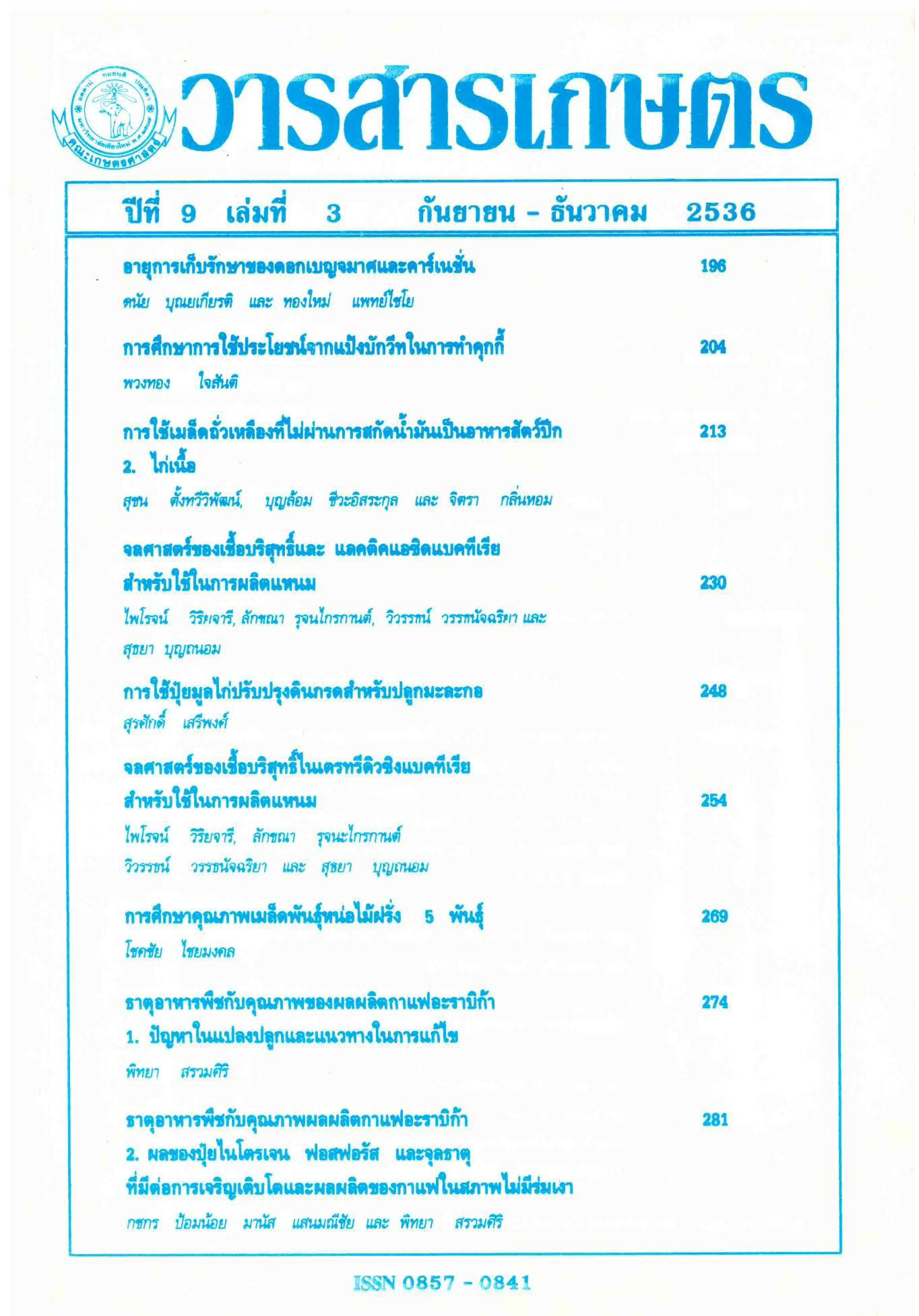จลศาสตร์ของเชื้อบริสุทธิ์แลคติคแอซิดแบคทีเรียสำหรับใช้ในการผลิตแหนม
Main Article Content
บทคัดย่อ
สารอาหารที่จำเป็นต่อการเจริญเติบโตของเชื้อจุลินทรีย์ที่ผลิตกรดแลคติคอย่างหนึ่ง คือ กลูโคส ได้นำมาใช้เป็นปัจจัยของการศึกษาจลศาสตร์ของเชื้อใน Model system โดยแปรที่ระดับความเข้มข้นร้อยละ 0.2, 0.5, 0.75, 1.0, 1.5 และ 2.0 ในระยะเวลา 24 ชั่วโมง จากการทดลองพบว่าเชื้อ Lactobacillus plantrum และ Pedicapas cereisiae มีค่า Specific growth rate (u) แปรผันตามค่าความเข้มข้นของสารอาหารเริ่มต้นและค่า maium specific growth rate (um) มีค่าเป็น 0.4525 ชั่วโมง-1 และ 0.340 ชั่วโมง-1 ตามลำดับ ส่วนค่า Saturation Constants (Ks) มีค่า ร้อยละ 0.1165 และ 0.3442 นั่นคือเชื้อ L. planterum ต้องการกลูโคสในการเจริญเติบโตอย่างน้อยที่สุด ร้อยละ 0.115 ส่วนเชื้อ P. cerevisiae จะต้องการกลูโคสในการเจริญเติบโตอย่างน้อยที่สุด ร้อยละ 0.3442 และเป็และเนื่องจากการเจริญเติบโตของเชื้อทั้งสองเป็นแบบ Growth associated fermentation ดังนั้นผลิตภัณฑ์ที่สร้างขึ้น (กรดแลคติค) ซึ่งขึ้นอยู่กับการเจริญของเซลล์จุลินทรีย์
Article Details
เอกสารอ้างอิง
วิริยจารี, ไพโรจน์. (2535). วิทยาศาสตร์และเทคโนโลยีการหมัก. ภาควิชาวิทยาศาสตร์และเทคโนโลยีการอาหาร คณะอุตสาหกรรมเกษตร มหาวิทยาลัยเชียงใหม่.
AOAC. (1984). Official Methods of Analysis (13rd edition) Association of Official Analytical Chemists, Washington, D.C.
Bacus, J. (1984). Utilization of Microorganisms in Meat Processing. Research Studies Press, Ltd., England
Bacus, J.N., and Brown, W.L. (1981). Use of microbial cultures: Meat products. Food Technol. 35: 74-78, 83.
Coretti, K. (1977). Starter cultures in the meat industry. Die Fleischwirtschaft. 3: 368-388.
Deibel, R.H., and Niven, C.F., Jr. (1957). Pediococcus cerevisiae: A starter culture for summer sausage. Bacteriol. Proc. 14-15.
Everson, C.W., Danner, W.E., and Hammes, P.A. (1970). Bacterial starter cultures in sausage products. J. Agr. Food Chem. 18: 570-571.
Everson, C.W., Danner, W.E., and Hammes, P.A. (1974). Process for Curing Dry and Semi-dry Sausages. U.S. Patent 3,814,817.
Gibbs, P.A. (1987). Novel uses for lactic acid fermentation in food preservation. J. Appl. Bacteriol. Symposium Supplement, 51S-58S.
Gilliland, S.E. (1985). Bacterial Starter Cultures for Foods. CRC Press, Inc., Baca Raton, Florida.
H-kittikun, A., Wiriyacharee, P., and Rujanakraikarn, L. (1988). Nham (Thai fermented pork) making with starter cultures. p. 427-429. In Proceedings 34th International Congress of Meat Science and Technology. Brisbane, Australia.
Miller, G.L. (1959). Use of dinitrosalicylic acid reagent for determination of reducing sugars. Analytical Chemistry 31: 426-428.
Niinivaara, F.P. (1955). The influence of pure bacterial cultures on aging and changes of the red color of dry sausage. Suomen Maataloustieteelisen Seuran Julkaisuja No. 84, Acta Agra Finnica (Helsinki). 97: 45-49.
Nurmi, E. (1966). Effect of bacterial inoculations on characteristics and microbial flora of dry sausage. Thesis, University of Helsinki, Finland. Acta Agra Finnica. No. 108.
Pearson, D. (1976). The Chemical Analysis of Food. Churchill Livingstone. London and New York. Pirt, A.J. (1975). Principles of Microbe and Cell Cultivation. Blackwell Scientific Publication. London. Wiriyacharee, P. (1990). The Systematic Development of a Controlled Fermentation Process Using Mixed Bacterial Starter Cultures for Nham, a Thai Semi-dry Sausage. Ph.D. Thesis in Product Development in Food Fermentation, Massey University, New Zealand.


